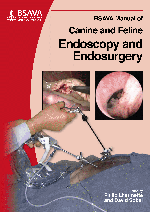
Full text loading...

PLEASE NOTE THAT A MORE RECENT EDITION OF THIS TITLE IS AVAILABLE IN THE LIBRARY
Examination of the lower urinary tract and reproductive tract is a core part of the diagnosis of various medical and surgical disorders of small animals. Historically, radiographic examinations were almost the sole way to investigate structural abnormalities, but more recently both ultrasonography and endoscopy have become essential additional modalities for diagnosis. Anatomical considerations limit the application of urethroscopy in male animals, especially the cat, but in females the entire urethra and the bladder are readily accessible to endoscopic evaluation. In the male, examination of the urethra may be possible in some dogs, using highly specialized equipment; the bladder of male dogs and cats is accessible via a transabdominal approach (laparoscopic or laparoscopically assisted cystoscopy). Interventional procedures in the lower urinary tract are still limited in application, but urolith removal and ablation, tissue biopsy, injection of bulking agents into the urethral wall, and palliation of urethral neoplasia have been reported. This chapter covers Anatomical considerations; Indications; Preoperative diagnostic work-up; Intraoperative diagnostic work-up (under general anaesthesia); Urethrocystoscopy; Transabdominal cystoscopy; Laparoscopic-assisted cystomy tube placement; Vaginoscopy in the bitch; Pathological conditions; Assessment of breeding time in the bitch; Cervical catheterization; Postoperative care; and Complications.
Rigid endoscopy: urethrocystoscopy and vaginoscopy, Page 1 of 1
< Previous page | Next page > /docserver/preview/fulltext/10.22233/9781905319572/9781905319572.10-1.gif

Full text loading...























